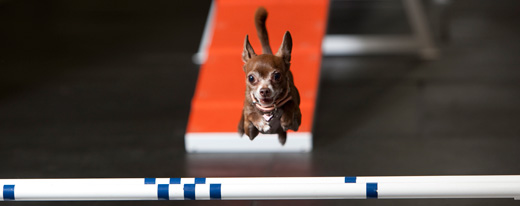
Dog Sports
It’s 7 a.m. on a Sunday morning and already the minivans are lined up and the crowds are waiting, coolers out, snacks at hand, picnic blankets spread out staking claim to the choicest spots for watching the competition. But these aren’t soccer moms watching their kids – the park is swarming with dogs – small ones, large ones, and everything in between – sleek and ready to compete. A woman is stretching her Corgi out, picking up his tiny legs one by one, and the loudspeaker crackles on as the event comes to life. The sport? Dog agility, an obstacle course encompassing jumps, tunnels, ramps, and more, where the fastest dog around the course wins.
Dog sports have grown in popularity over the past twenty years, when the only competition your dog might face was who got the best spot on the couch. Today, dog sports are big business, with events held nationwide and big name sponsors on board for televised events. Animal Planet and even ESPN broadcast countless events each year, ranging from Earth Dog (tunnel work) to Flyball and Dog Agility.
Benefits of Dog Sports
Getting your dog involved in a sport is great for his health. Increased muscle tone and strength can help your dog maintain a healthy weight and prevent injuries. Obesity in dogs is linked to many health problems, and in addition, many experts think that a solid exercise program can stave off, or at least retard, hip dysplasia. Participating in a dog sport can also be beneficial for you. Besides the obvious physical exercise for your dog, getting your dog over jumps or catching frisbees will get your heart pumping as well.
Participating in a dog sport can have positive benefits on your dog’s behavior, too. Many people decide to get their dog involved in a sport because the dog is, quite frankly, driving them crazy. Dogs that are “busy” need mental stimulation or they’ll quickly invent their own – which may be remodeling your back yard with potholes or thinning out your wardrobe by chewing up all your shoes. While not a cure-all for behavior problems, many people that participate in dog sports report that their dogs are in general more responsive and focused. Most dog sports require that you be able to communicate with your dog – “jump this, catch that” – and this ability to direct your dog definitely seems to cross over into everyday life.
In addition to the mental exercise that structured dog sports provide, the physical exertion does two things for behavior: it releases endorphins in your dog’s limbic system, which can help your dog feel less frustrated and happier (don’t you feel better after a workout?), and perhaps more importantly, it tires them out. There’s a reason A tired dog is a good dog is the mantra of so many dog trainers. The focus required to complete tasks seems to work double-duty to exhaust them; your dog exerts more effort to concentrate on an actual dog sport than he does just running wild at the dog park.
It’s critical to find the right sport for you and your dog in order to really get the most benefit – if you’re not both enjoying yourself, why do it? Luckily, there are tons of options out there. Depending on your dog’s temperament, he or she may have an affinity for certain specialty dog sports.
Dog Agility
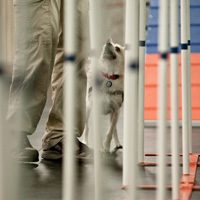 Kathy Lofthouse, a national agility competitor and instructor, remembers what it was like years ago when agility was just getting started in this country. “There was no one competing, everyone thought we were these crazy dog people.” Now, agility is the fastest-growing dog sport nationwide, with competitors from Chihuahuas to Great Danes competing to see who can dash around the ring the fastest.
Kathy Lofthouse, a national agility competitor and instructor, remembers what it was like years ago when agility was just getting started in this country. “There was no one competing, everyone thought we were these crazy dog people.” Now, agility is the fastest-growing dog sport nationwide, with competitors from Chihuahuas to Great Danes competing to see who can dash around the ring the fastest.
Agility appeals to many people because it’s fast, fun, and even beginner dogs can have a blast on the agility course. You work in tandem with your dog to guide her over and around obstacles, which are raised or lowered depending upon your dog’s size. The caveat to this is that it’s done completely off-leash, which means you’ll use your voice and body language to communicate to your dog where to go. While off-leash control many seem a distant dream to many dog owners, starting with a basic agility class can help you focus your dog and develop distance commands. Group classes are available for about the same amount of money that you’d spend on obedience classes, and while you could start agility training in your backyard with a jump or two, specialized equipment will mean you’ll have to work with a training center to learn all the obstacles.
The Zoom Room specializes in dog agility, and has a growing number of locations nationwide, providing plenty of year-round opportunities for agility training on an indoor, climate-controlled course.
Disc Dog
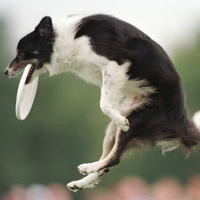 Disc Dog probably requires the least amount of equipment to start. You just need a Frisbee (or any flying disc) and a dog that will chase one.
Disc Dog probably requires the least amount of equipment to start. You just need a Frisbee (or any flying disc) and a dog that will chase one.
You can easily start your pup in Disc Dog in your backyard or a local park, and as you start to get the hang of it, enroll in a class or attend a seminar to fine-tune your skills. Border Collies, Retrievers, and other “ball-crazy” dogs do especially well at Disc Dog.
High-level competitors have complicated routines that involve spinning, twirling and lots and lots of discs; some even participate in half-time shows at football games!
Dog Herding
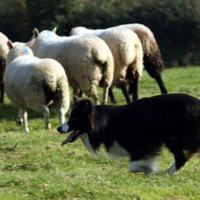 Dog Herding – yes, as in herding sheep – is a great activity for dogs with an inclination to control the world around them – shepherds, working dogs and other herding breeds all seem to enjoy it. While certainly some dogs have a genetic predisposition to herding, like Collies and Shelties, you may not realize that other breeds like the Rottweiler also excel. And yes, German Shepherds are in fact herding dogs.
Dog Herding – yes, as in herding sheep – is a great activity for dogs with an inclination to control the world around them – shepherds, working dogs and other herding breeds all seem to enjoy it. While certainly some dogs have a genetic predisposition to herding, like Collies and Shelties, you may not realize that other breeds like the Rottweiler also excel. And yes, German Shepherds are in fact herding dogs.
Dog herding normally requires that you visit a herding trainer, who will help you and your dog learn how to safely herd livestock, normally sheep or goats. Costs vary to get involved, but count on travel to somewhere where keeping livestock is permitted.
Dock Dogs
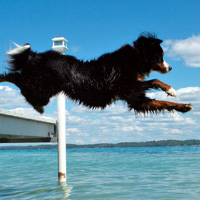 Dock Dogs take part in Dock Diving – also called dock jumping. This dog sport is made for ball-crazy Retrievers (or any other dogs) that don’t mind getting wet.
Dock Dogs take part in Dock Diving – also called dock jumping. This dog sport is made for ball-crazy Retrievers (or any other dogs) that don’t mind getting wet.
Dock Dogs leap off a dock in pursuit of a toy thrown into the water, and the dog with the longest jump wins. For practice purposes, you must have a pool or access to a body of water with a dock. It’s a great spectator sport, too.
Find out about local Dock Dog events at dockdogs.com or splashdogs.com.
Lure Coursing
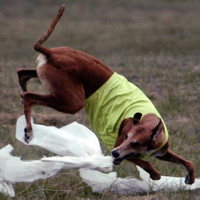 An ancient dog sport dating back thousands of years, Lure Coursing was used to help develop hunting skills in sighthounds, who use their eyes to track fast prey like rabbits.
An ancient dog sport dating back thousands of years, Lure Coursing was used to help develop hunting skills in sighthounds, who use their eyes to track fast prey like rabbits.
These days, Lure Coursing compeitions employ a mechanical lure, which is whipped around a field as dogs give chase. The fastest dog is declared the winner. Sighthounds like Whippets, Greyhounds and Salukis excel at this sport.
Visit the American Sighthound Field Association for more information about Lure Coursing competitions.
Flyball
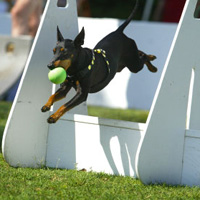 Remember relay races? Well now you can relive those adrenaline-filled moments with your dog thanks to Flyball. In a Flyball competition, each dog clears small hurdles to hit a special flyball box, which pops a ball into the air. The competing dogs quickly grab the launched ball and book it back to the start by leaping over the hurdles, and then the next dog takes his turn in the relay.
Remember relay races? Well now you can relive those adrenaline-filled moments with your dog thanks to Flyball. In a Flyball competition, each dog clears small hurdles to hit a special flyball box, which pops a ball into the air. The competing dogs quickly grab the launched ball and book it back to the start by leaping over the hurdles, and then the next dog takes his turn in the relay.
Timing, speed and accuracy are critical factors for succeeding at Flyball, a truly fast-paced dog sport.
To find a local Flyball team and try it out with your dog, go to flyball.org or flyballdogs.com.
Rally Obedience
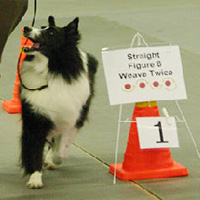 Often considered to be a stepping stone into the competitive obedience world, competitors in Rally Obedience guide their dogs through a course where they must perform obedience exercises such as turns, down-stays and heels. If you’re looking to polish up your dog’s obedience skills this is the dog sport for you.
Often considered to be a stepping stone into the competitive obedience world, competitors in Rally Obedience guide their dogs through a course where they must perform obedience exercises such as turns, down-stays and heels. If you’re looking to polish up your dog’s obedience skills this is the dog sport for you.
Several organizations host Rally Obedience events and many obedience schools offer classes. Learn more about Rally Obedience classes and competitions from the AKC or the Association of Pet Dog Trainers.
Earth Dog
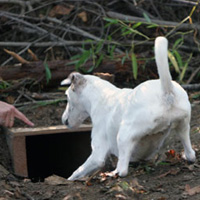 If you have a Terrier that won’t leave the squirrels in your backyard alone, Earth Dog may be the sport for you.
If you have a Terrier that won’t leave the squirrels in your backyard alone, Earth Dog may be the sport for you.
In Earth Dog competitions, small Terriers originally bred to “go to ground” after game like raccoons, badgers and woodchucks compete by following an underground maze to reach the prize – a caged mouse. Earth Dogs must use their senses in the dark to find the correct path – and speed counts, too!
Visit dirtdog.com for more information about Earth Dog competitions.
Dog Sports
Participating in dog sports does not necessarily mean that you have to compete, although many people love the thrill of competition. Dog competitions are typically held on weekends, and require registration in advance through the organizer, usually at least four weeks ahead of time. At one time, many dog competitions were limited to pure breeds, but now, mixed breeds are also permitted in many competitions. In fact, the American Kennel Club just passed regulations allowing mixed breed dogs to compete in agility, tracking, obedience and other non-conformation events (conformation measures the dog according to breed standard, like at Westminster).
The drawback to competing for many owners of sportdogs is cost and travel time. Competitors who get the bug soon find themselves driving all over the state (and beyond) to attend events, which can quickly exhaust your bank account. However, many competitors make great friends within the dog community and quickly find a social niche with like-minded individuals. For those that want to keep the competition lower-key, fun matches are often held locally involving less pressure and less cost. (The Zoom Room, for example, holds a weekly Agility League, with the emphasis more on camaraderie than cut-throat competition.)
Sportdogs
Sportdogs come in all shapes and sizes. Besides deciding upon a sport based upon your dog’s breed or temperament, you must first consider his health. Before getting started in any dog sport, make sure that your dog (and you) are healthy enough to participate. If your dog hasn’t had a physical exam in the last year, take your dog to the veterinarian for an annual work up. You should also inquire about vaccines that might be required, since participating in a sport might put your dog in contact with a lot of other sportdogs – and their germs. If your dog has ever been injured, make sure that he or she is completely healed before attempting new activities.
Puppies and Dog Sports
Young puppies should participate in programs where the emphasis is on building a bond with you and on developing their balance, coordination, and self-confidence, not creating an Uber-Pup. Puppies need time to grow and mature, so a solid foundation of fun should underly any sport work with them. Some training centers have special puppy classes that take into account the immaturity of both personality and growing joints. Be careful not to tax your puppy too much too soon, but exposing your young dog to new experiences is an excellent way to continue socialization. (Learn more about the importance of Puppy Socialization.)
Older Sportdogs
Similarly, owners of older dogs should approach new sports carefully, making sure that increased or novel exercise isn’t causing injuries. Some dog sports, like tracking, in which the dog follows a scent trail, are excellent low-impact activities for older dogs.
Whatever breed, age or size your dog, participating in dog sports will enrich your dog’s life. Plus, you’ll benefit by developing a true working bond with your dog, and who knows, maybe some day your canine athlete will be a champ, so what are you waiting for?


Leave a comment